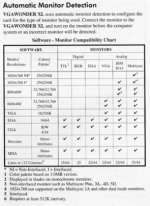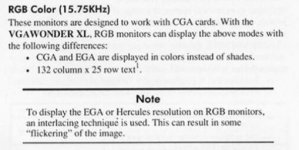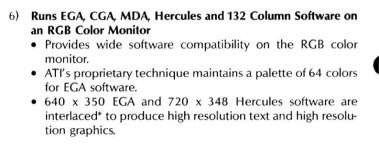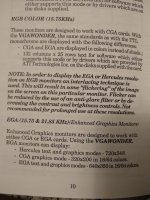chjmartin2
Experienced Member
- Joined
- Dec 26, 2012
- Messages
- 430
Hi,
I am curious about this and can't seem to find an internet or forum reference that has tested it out. I want to do it myself but don't have an appropriate XT in a condition to do so - yet. Specifically I am curious what capabilities you get when you hook up a TTL CGA monitor to the card or a Monochrome TTL. I can only find the ATI Wonder XL manual but it says some really interesting things. Full manual Link. Here is the monitor selection table:

If you look it says that if you use a TTL monitor that you get "shades" for EGA/CGA modes. It also shows EGA as 16/64 and CGA as 4/16. I have seen for sure 16 shades on a monochrome TTL and we know that a CGA monitor has 16 colors. I am well aware we get 320x200x16 EGA on a CGA Monitor and 320x200x16 grays EGA on a Monochrome TTL Monitor. I am curious how the 16 shades are created on the Monochrome TTL. This video shows EGA 16 on an IBM 5151 - it LOOKS like 16 shades of grey but I can't completely tell.
So now here is where it gets interesting to me. It says it can use interlace to display EGA resolutions on a TTL monitor - is that right?

So then I found a tidbit in an EGA Wonder manual (I know they are different) that gave me pause as well.

So I guess my overall question is does the VGA Wonder work the same as the EGA Wonder for EGA modes when attached to a TTL Monitor. I do not have an EGA Wonder but do have a VGA Wonder. Lastly, WHAT EXACTLY IS THE PROPRIETARY TECHNIQUE!?!? Like, does the EGA Wonder REALLY allow 64 colors on a Digital TTL Monitor that can only display 16 colors? Is it using Pulse Width Modulation or some other voodoo magic? It is truly 64 shades of gray? Can it REALLY even do 640x350x16 and not just the regular RGBI colors?
Does anybody have an EGA Wonder that can show us this ATI Magic??? Lastly, does the VGA Wonder do the same magic for EGA modes? I love CGA and I love CGA Monitors but I can't get over the fact that there might me MORE than 640x200x16 which of course using a Tandy we have seen.
Thanks,
Chris
I am curious about this and can't seem to find an internet or forum reference that has tested it out. I want to do it myself but don't have an appropriate XT in a condition to do so - yet. Specifically I am curious what capabilities you get when you hook up a TTL CGA monitor to the card or a Monochrome TTL. I can only find the ATI Wonder XL manual but it says some really interesting things. Full manual Link. Here is the monitor selection table:

If you look it says that if you use a TTL monitor that you get "shades" for EGA/CGA modes. It also shows EGA as 16/64 and CGA as 4/16. I have seen for sure 16 shades on a monochrome TTL and we know that a CGA monitor has 16 colors. I am well aware we get 320x200x16 EGA on a CGA Monitor and 320x200x16 grays EGA on a Monochrome TTL Monitor. I am curious how the 16 shades are created on the Monochrome TTL. This video shows EGA 16 on an IBM 5151 - it LOOKS like 16 shades of grey but I can't completely tell.
So now here is where it gets interesting to me. It says it can use interlace to display EGA resolutions on a TTL monitor - is that right?

So then I found a tidbit in an EGA Wonder manual (I know they are different) that gave me pause as well.

So I guess my overall question is does the VGA Wonder work the same as the EGA Wonder for EGA modes when attached to a TTL Monitor. I do not have an EGA Wonder but do have a VGA Wonder. Lastly, WHAT EXACTLY IS THE PROPRIETARY TECHNIQUE!?!? Like, does the EGA Wonder REALLY allow 64 colors on a Digital TTL Monitor that can only display 16 colors? Is it using Pulse Width Modulation or some other voodoo magic? It is truly 64 shades of gray? Can it REALLY even do 640x350x16 and not just the regular RGBI colors?
Does anybody have an EGA Wonder that can show us this ATI Magic??? Lastly, does the VGA Wonder do the same magic for EGA modes? I love CGA and I love CGA Monitors but I can't get over the fact that there might me MORE than 640x200x16 which of course using a Tandy we have seen.
Thanks,
Chris



